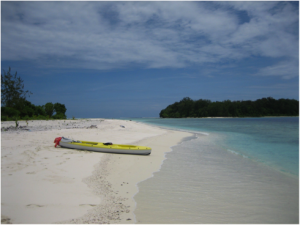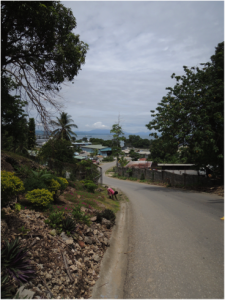by Sophie Webber (UBC Geography)
I just returned from five weeks of dissertation fieldwork in Solomon Isla nds. My friends and family are always jealous of my research trips, thinking they look something like this photo.
nds. My friends and family are always jealous of my research trips, thinking they look something like this photo.
Of course it does; Solomon Islands has wonderful snorkeling and beaches. But I spent my time in Honiara the capital, interviewing Solomon Islands Government officials and representatives of development partners including bilateral donors, regional organizations, and large, international non-governmental organizations.
I was interviewing these personnel with a couple of objectives. First, I am interested in understanding the differences – in theory, and in practice – between putative Development interventions, and Adaptation ones. I am trying to understand why it matters to certain development actors whether a project is called climate change adaptation, or, say, an education investment. And second, I asked questions about how these climate change adaptation, resilience, and risk management programs incorporated scientific information – including projections, scenarios, and short-term forecasts. In particular, I am trying to figure out how uncertainty around precise future climate change impacts are worked around and incorporated.
And despite the above picture, this was actually challenging work. Unlike other countries in the Pacific where I have done research, conducting fieldwork in the Solomon Islands is not challenging for logistical or comfort reasons; I really like Honiara – despite a disastrous previous experience involving the Number 9 Hospital, so called because it is apparently the last stop before the Number 10 cemetery. It’s a bustling and friendly city, and there is as much pineapple, coconut, and papaya a person could eat. It looks a bit more like this:
Instead, the challenges were more substantive. There is a lot of climate change investment happening, but it is distributed far and wide amongst so many of these development partners, and there are so, so many of them. Perhaps the best descriptor for the climate change adaptation action is thin: all interested parties will tell you that they have mainstreamed climate change into their planning, and they really did want to be ‘part of my study’. But during conversations, we couldn’t articulate to each other what this climate change ‘mainstreaming’ actually consisted of. I left the country with a sense that there were some fascinating things happening, but that I hadn’t quite gotten my finger on it.
There were some intriguing exceptions to this. For instance, as a component of the all-round-fascinating Pacific-Australia Climate Change Science and Adaptation Planning Program and a huge, multi-donor transport infrastructure development program, some risk management specialists are developing manuals and guidelines to help the Solomon Islands Ministry of Infrastructure Development consider climate change projections. Some civil engineers proclaim that their engineering approach and systems can easily incorporate future climate change impacts – for them, it’s really no big deal. Yet, ‘mainstreaming’ in one instance led to some wharves being vastly over-specified, to the extent that even at high tide, they are inoperable. In another case, supposedly ‘climate-proofed’ roads and road crossings were recently flooded, within just a few years of being built. And then, what happens when downscaling, or updated research dramatically changes projected climate impacts? I hope to explore these illuminating conjunctures further in my dissertation.


